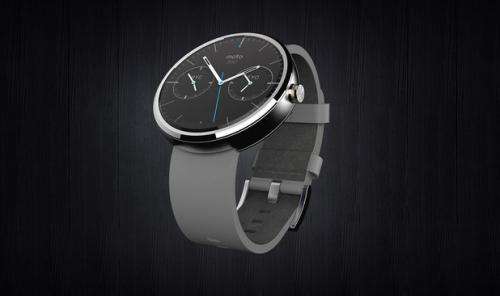Review: Moto 360 smartwatch is no perfect circle

Outside of Apple Watch, Motorola's Moto 360 has been the most widely anticipated smartwatch of late.
Unveiled at Google's I/O devlopers conference in June, the Moto 360 was pitched as a flagship device for Android Wear, Google's new software for wrist-based gadgets. With a rounded face and metal case, the Moto 360 was supposed to be a step above its Android Wear rivals.
Motorola finally released the Moto 360 earlier this month, and I tested it last week. While it may be the best Android Wear device on the market, that's not saying a lot in its favor.
The Moto 360 suffers from the same shortcoming that plagues all smartwatches right now: There's no killer app or compelling need to own one. Nearly everything you can do on a smartwatch can be done better or more easily on a smartphone. Which raises the question of why anyone would need to have both.
The Moto 360 also, like many smartwatches, does a terrible job at something that should be one of its primary functions: displaying the time. To save power, the Moto 360 and many of its rivals dim or turn off the screen most of the time, so you can't just glance at your wrist to check the time. Instead, you have to bring the watch to your face or even tap or jostle it. If you're going to have to do that, why not just pull out your phone?
Yet here we are. Silicon Valley is banking that wearable devices - and smartwatches in particular - are the next big wave in personal computing, so you'll be seeing many more devices like the Moto 360 soon. Apple jumped into the game last week when it unveiled its new Watch, which will be available sometime next year.
The most distinctive thing about the Moto 360 is its round face. Most other smartwatches on the market are either square or rectangular, which, combined with their LCD screens, makes them look more like techy gadgets than classy timepieces.
The Moto 360's simple circular design at least gives it the potential to look like something less geeky. With its stainless steel case and leather strap, it also feels solid and, if not expensive, at least not cheap.
But its fashion potential is undermined by both its thickness and its screen. The Moto 360 is more than a centimeter thick, meaning that it rises noticeably off your wrist. While it's fairly lightweight - weighing in at less than 2 ounces - it's no slender timepiece.
Meanwhile, its screen is of relatively low resolution, which means that when it displays a clock face, it doesn't look like anything close to a real watch. Instead, it resembles the paper faces on the fake plastic watches kids used to get as grab-bag gifts at birthday parties.
The differences between the Moto 360 and other Android Wear devices are only on the surface. It basically works the same as its rivals.
As conceived by Google, Android Wear works generally as an extension of an Android smartphone rather than as an independent computing device. So by themselves, the first generation of Android Wear devices can do very little. They can tell you the time, keep track of appointments they've already downloaded, act as pedometers and monitor your pulse rate - and that's about it.
When paired with a smartphone, they essentially act as a second screen for it. Android relays alerts from a smartphone to the watch, as well as things like point-by-point directions and messages.
These notifications can quickly become annoying and overwhelming. I get lots of email each day, few of which I actually need to be alerted to. Yet the Moto 360 faithfully let me know whenever a new message or batch of messages arrived.
In some cases, users can interact with smartphone apps, typically using Google Now, the intelligent assistant feature included with Android. So, by talking to their watch, users can ask for directions or respond to an email.
But many apps don't yet work with Android Wear. The app I use to track my dog walks, for example, doesn't interact with Android Wear, despite working with other smartwatches and fitness bands. I couldn't use my watch to monitor my walk, much less actually start or stop the app's tracking feature.
Other apps offer only limited interaction with Android Wear. For example, the Moto 360 would tell me when I received new email on my corporate mail account. But the only option it offered me to interact with those messages was to open them on my phone.
Even some apps that offer deeper integration with Android Wear aren't all that fun to use. You can actually view and respond to messages sent to your Gmail account on the Moto 360. But trying to read a message - or craft a response - on that tiny screen was difficult at best.
I did find one app that offered a glimpse of what you might do with a smartwatch. The Allthecooks app will beam recipes from your phone to your watch, allowing you to go through them step by step without having to constantly reach for your phone. I could actually see myself doing that.
But that's not a compelling enough for me to recommend the Moto 360 - or any other smartwatch - at least not yet.
—-
What: Motorola Moto 360 smartwatch
Likes: Lightweight, metal case, round design
Dislikes: Does little without phone near by; dims or darkens screen when not in use, making it difficult to see time; inconsistently responds to wake-up gesture; notifications can be overwhelming; small screen makes reading, responding to messages difficult.
Specs: 1.56-inch, 320 x 290 screen, 4GB storage
Price: $250
Web: motorola.com
©2014 San Jose Mercury News (San Jose, Calif.)
Distributed by MCT Information Services





















